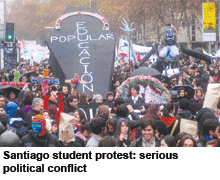It was back in May, in the southern hemisphere autumn, when Chile’s students and many schoolchildren began taking to the streets to demand wholesale reform of the education system. Now spring has come, but there is no sign of settling what has transformed into the most serious political conflict for two decades in Latin America’s most successful country. Talks between the students and government began in August, but broke down on October 5. Chile is paying an increasingly high price for the deadlock.
 Students have occupied hundreds of schools since May, locking out teachers and depriving tens of thousands of children of education. Many university students have not been to classes for months. Most weeks they stage marches, often unauthorised, in Santiago, the capital. Predictably, these end in clashes between a minority of violent youth and police.
Students have occupied hundreds of schools since May, locking out teachers and depriving tens of thousands of children of education. Many university students have not been to classes for months. Most weeks they stage marches, often unauthorised, in Santiago, the capital. Predictably, these end in clashes between a minority of violent youth and police.
The students’ underlying cause remains popular. Education is expensive, and parents pick up most of the bill. Nearly 40 percent of spending on schools and higher education is made by households — by far the highest figure in the OECD, a group of mainly rich countries. Almost half of pupils attend what are known as ‘subsidised’ schools, where costs are split between the state and parents, who pay on average $400 (Rs.20,000) per child a year (in a country where the monthly minimum wage is $363). Only 15 percent of spending on higher education comes from public sources, compared to an OECD average of 69 percent. The rest comes from households.
What makes this harder to stomach is that many educational establishments are profit-making businesses. That is true of a third of secondary schools and technical and vocational colleges attended by two-thirds of students in higher education. Three-quarters of universities are private. In 1981 they were barred from making profits, but many have got around this restriction by setting themselves up as property companies which lease their premises to the universities.
The students argue, correctly, that education is a public good. Less justifiably, they want the whole system to be “free” (i.e, paid for by the taxpayer) and run by the state. They want these two demands put to a plebiscite. The government says universal state funding would be a subsidy to the rich. President Piñera, himself a businessman, has no qualms about schools making a profit. At least two of his ministers have past links to educational businesses, as do prominent opposition politicians.
The government has sent a Bill to Congress to cut the interest rate on student loans from 6 percent to 2 percent, and says that the poorest 40 percent of students will receive grants. It will also gradually transfer municipal ‘subsidised’ schools to the education ministry, but not make them free. It has proposed a 7.2 percent rise in education spending in next year’s budget. In what has become a polarised argument, other vital issues such as the quality of teaching or evaluations of school performance have hardly been broached.
Polls show that education has become Chileans’ top concern. Over the past 20 years, the number of students in higher education has quadrupled; many of them are the first in their families to get there. And if Chile is to achieve Piñera’s aim of becoming a developed country, it needs a better-educated workforce. The government is surely right to resist a wholly taxpayer-funded, state-run system. But it should also note that the world’s top universities are non-profit bodies, and that Chile is distressingly far from providing equal opportunities for its people.
(Excerpted and adapted from The Economist)